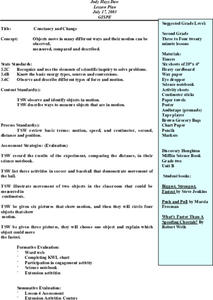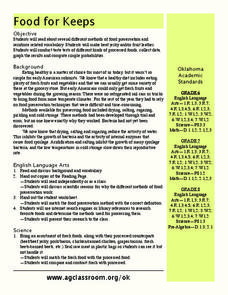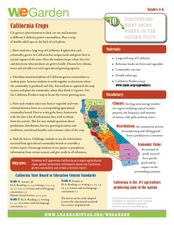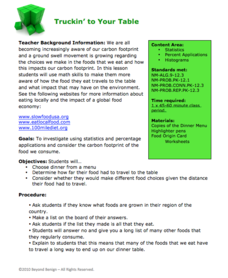Alabama Learning Exchange
Classification
Students examine why scientists classify living organisms. They list and classify items they buy at the grocery store, sort and classify leaves, explore various websites, and write a biography of Carolus Linnaeus.
Curated OER
Edible Algae
Students acquire an awareness and appreciation for the value of the organisms in the Protist Kingdom. They identify common Protists, name them and list some common products that contain marine algae.
Curated OER
What's the Price?
Fourth graders learn about price and comparative shopping. In this price and comparative shopping lesson, 4th graders read Amy Axelrod's, Pigs Go To Market: Fun with Math and Shopping. They use the book to investigate the meaning of...
Curated OER
Stopping Decay
Students review reasons why teeth are necessary, define tooth decay, discuss and list ways to prevent tooth decay, name at least two foods that promote dental health, watch video Tooth Wisdom, and complete worksheet Tooth Healthy Snacks.
Curated OER
Not Everything is More Expensive
Students compare prices and determine percent increases and decreases of items in order to make wise purchases. In this percent increases and decreases lesson plan, students calculate the amounts based on grocery store ads.
Curated OER
Party Time
Students engage in a lesson about finding information from the grocery store to put into data that can be measured. The data is found in advertisements and food labels. They plan the cost of a party when using the unit cost of various...
Curated OER
Understanding My Pyramid
Students examine the food pyramid and construct a healthy meal. For this food pyramid lesson, students examine the new food pyramid that includes fats and oils, and is arranged with brightly colored triangles. They use grocery store adds...
Curated OER
Constancy and Change
Second graders investigate how objects can move in different ways. They move in different ways across the room and develop a class list of movement words. Students also conduct a measuring motion experiment, create a bar graph for the...
Curated OER
Diversity of Trees
Fourth graders explore the uses of trees, In this trees lesson, 4th graders discover the uses of trees and how we use them everyday. Students collect items and decide if they are made from trees, have a scavenger hunt for wood products...
Curated OER
Sentence Maker 2
In this writing worksheet students learn how to write a great sentence. Students analyze 6 columns labeled with the parts of speech which have many word possibilities listed. Students choose one word from each column to write sentences...
Curated OER
Social Studies and Economics
Students investigate the products agriculture provides in raw materials. In this agriculture products lesson, students make a list of common items used and foods eaten. Students work in teams to categorize agriculture products based...
Curated OER
Food For Keeps
Students explore food. In this processed and fresh foods lesson, students discover how some foods are processed and how they differ from fresh food. The complete group activities and an individual reading assignment. This lesson includes...
Curated OER
California Crops
Young scholars explore agriculture by researching the native food crops of California. Students define a list of agriculture vocabulary terms and analyze maps of California which explain which foods come from which area. Young scholars...
Curated OER
Make Slime
Students make slime. In this chemical reaction lesson plan, student use Borax to make a gel like solution. Students add all ingredients listed, add food coloring, and mix well. Students see first hand how chemicals react together...
Curated OER
Computer Tracks Lunch Choices
Students read a story called Computer Program Tracks Lunch Choices and answer vocabulary and comprehension questions about it. In this current events literacy lesson plan, students respond to literature by answering questions, recalling...
Council for Economic Education
Sand Art Brownies
Which is better, Coke or Pepsi? Pupils analyze the concept of substitute goods as they investigate the choice to purchase alternate products for better prices. Fun and practical, the engaging shopping exercise helps savvy scholars get...
Salt River Project
How Do We Clean Polluted Water?
How do we clean up oil spills and other pollutants in the water? Explore water treatment strategies with a set of environmental science experiments. Groups remove oil from water, work with wastewater treatment, and perform a water...
Beyond Benign
Truckin’ to Your Table
Food takes a trip to the table. Class members choose a meal from a menu and calculate the total cost of the meal including tax and tip. Using a food origin card, pupils determine how far each of the ingredients of a meal traveled to end...
Lunch Lab
Exercise
This is the perfect resource for helping youngsters understand the importance of physical activity in their daily lives. The lesson and its worksheets focus on brainstorming a variety of fitness activities, such as games you can...
Novelinks
Tunes for Bears to Dance to: Concept Analysis
Considering using Robert Cormier's young adult novel, Tunes for Bears to Dance to for book circles or as a whole-class anchor text? Check out this overview of the key concepts and issues raised by the novel.
Curated OER
Moving Out
Learners determine their cost of living. In this determining their cost of living instructional activity, students think of ten necessary things they would need if they moved out of their parents house. Learners research the...
Curated OER
Food Travels and Preservation
Young scholars complete a worksheet. In this food distribution and preservation lesson, students learn about the transportation of agricultural projects. Young scholars list foods that they buy at the grocery store and then identify how...
Nemours KidsHealth
Obesity: Grades 3-5
What is obesity and what are some steps that can help? Investigate obesity by having your class read and discuss articles about obesity. Learners gain knowledge about body mass index, the food pyramid, being overweight and dieting. They...
Curated OER
Reading the River - Biological Classification
Youngsters create a list of grocery store items and then work together to categorize them as if they were setting up the shelves of the market. Then they are given a box of miscellaneous objects to practice categorizing. With these two...
Other popular searches
- Making a Grocery List
- Unit Rates Grocery List
- Typing a Grocery List
- Grocery List Special Ed
- Grocery List Math
- Grocery List Prewrite
- Grocery List Rewrite
- Grocery List Lessons























